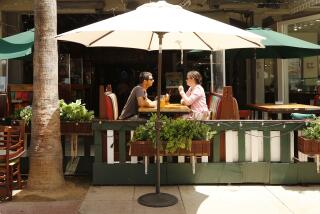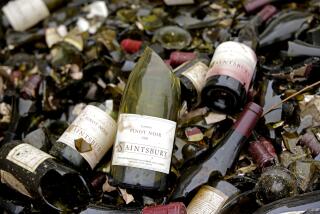Beating the Bubble Tax
When the giant Italian wine producer Zonin decided a few years ago to make a Prosecco sparkling wine for the United States market, it realized that if the wine was as sparkling as it usually is, luxury taxes would push the price too high. So they hit on a way to make a nice wine that avoids most of the tax--they cut back on the bubbles.
The federal and state excise taxes on a bottle of sparkling wine in California are almost 75 cents a bottle. And by the time that tax has ratcheted its way through the three-tier marketing system, it’s almost $1.50. The tax on non-sparkling wine is about 26 cents a bottle.
Of course, when that additional $1.50 is added to the $60 price of a bottle of Dom Perignon, no one blinks. But Zonin knew that the added $1.50 on top of its price for the Prosecco, which sells for well under $10 a bottle, could make a real difference.
So Zonin developed the wine, called Vivace, by a technique that gives it bubbles, but not as many as you’d find in a typical bubbly. Other Vivace semi-sparkling wines include a Chardonnay (with fresh, attractive aromas, if a bit soft); a wonderful wine called Primo Amore (a sweeter wine more like Asti Spumante), and a Merlot that reminds me of Brachetto d’Acqui, the slightly bubbly red wine of Italy that is usually sold only locally and rarely is seen in the United States.
Technically, a wine qualifies as sparkling when the percentage of submerged CO2reaches .392 grams per hundred milliliters. Vivace , which means “lively” in Italian, is made with a level of just .372, so it is not “sparkling” in a legal sense, though it has ample bubbles.
The disparity between excise taxes on sparkling and still wines goes back to just after Prohibition. At that time, almost all the bubbly sold here was French Champagne; almost no sparkling wine was made in the United States.
Congress decided that, since Champagne was consumed only on special occasions such as birthdays, World Series victories and elections, it warranted a far stiffer federal excise tax than table wine.
“Congress felt the only people who drank Champagne were the affluent,” says John De Luca, president of Wine Institute, the San Francisco-based trade association of the California wine industry. “Since it was then purely an imported product, they saw this as a tax on the affluent and on the French.”
The federal tax on sparkling wine has been $3.40 a gallon for nearly 40 years. California state tax adds another 30 cents per gallon. Table wine, on the other hand, is taxed at a rate of $1.07 per gallon by the federal government, 20 cents per gallon by the state.
The Vivace wines are made by first fermenting grape juice into wine, then adding unfermented juice to start a second fermentation and capturing some of the bubbles. Since the juice may not come from the same vintage as the majority of the wine, the final product is not vintage dated.
Coincidentally, the new Vivace was just being introduced two weeks ago when, in a monumental move, New York cut its state sparkling wine tax from 95 cents per gallon to 19 cents per gallon.
De Luca says he believes that was the first time in more than a half century that an alcoholic beverage tax was cut. He says his office could find only one other instance in modern U.S. history of an alcohol tax going down--in the 1930s when the federal tax on a gallon of wine was cut from 2 cents to a penny.
“We consider this unprecedented and we hope to use it as a prototype in those states where there is a huge disparity between table wine and sparkling wine taxation,” he says.
“In our judgment, economic activity in general was hurt by (the older) tax,” De Luca continues. “Reducing it will encourage sales of sparkling wine.”
Adds James Trezise, head of the New York Wine and Grape Foundation: “The concept is: lower the price (of sparkling wine) for the consumer, increase consumption as a result; and then increase production as a result, and then increase investment and jobs as a result. . . . It makes sense for everybody.”
More to Read
Eat your way across L.A.
Get our weekly Tasting Notes newsletter for reviews, news and more.
You may occasionally receive promotional content from the Los Angeles Times.










